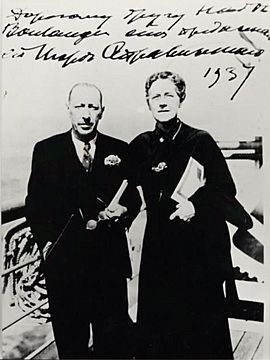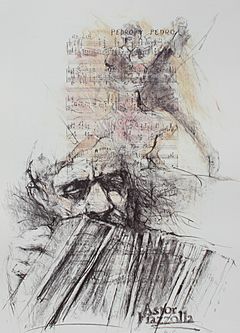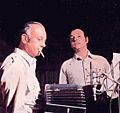Astor Piazzolla facts for kids
Quick facts for kids
Astor Piazzolla
|
|
|---|---|

Piazzolla with his bandoneon, 1971
|
|
| Background information | |
| Birth name | Astor Pantaleón Piazzolla |
| Born | March 11, 1921 Mar Del Plata, Argentina |
| Died | July 4, 1992 (aged 71) Buenos Aires, Argentina |
| Genres | Tango, nuevo tango |
| Occupation(s) | Musician, composer, arranger |
| Instruments | bandoneon |
| Years active | 1933–1990 |
| Associated acts | Aníbal Troilo, Nadia Boulanger, Roberto Goyeneche, Edmundo Rivero, Amelita Baltar, Gerry Mulligan, Pino Presti, Tullio De Piscopo, Horacio Malvicino, Gary Burton |
Astor Pantaleón Piazzolla (born March 11, 1921 – died July 4, 1992) was an amazing Argentine tango composer, bandoneon player, and arranger. He changed traditional tango into a new style called nuevo tango. This new style mixed parts of jazz and classical music. Astor was a very skilled bandoneon player. He often played his own songs with different music groups. A music critic once called him "the world's foremost composer of Tango music."
Contents
Biography
Childhood and Early Life
Astor Piazzolla was born in Mar del Plata, Argentina, in 1921. He was the only child of Italian immigrant parents. His family moved to New York City in 1925. They lived in a tough neighborhood. Astor learned to take care of himself there.
At home, he listened to his father's tango records. He also heard jazz and classical music, like Bach. In 1929, his father bought him a bandoneon, a type of accordion. Astor started playing it.
In 1932, Astor wrote his first tango song. The next year, he took music lessons. His teacher, Béla Wilda, taught him how to play Bach. In 1934, he met Carlos Gardel, a famous tango singer. Astor even had a small role in Gardel's movie. Gardel asked Astor to join his music tour. But Astor's father said he was too young to go. This turned out to be lucky. In 1935, Gardel and his whole orchestra died in a plane crash during that tour. Astor later joked that if he had gone, he would have played the harp!
Starting His Music Career
In 1936, Astor returned to Mar del Plata with his family. He started playing in different tango orchestras. He loved the new tango style of Elvino Vardaro's sextet. This inspired him greatly.
In 1938, Piazzolla moved to Buenos Aires. The next year, he joined Aníbal Troilo's orchestra. This was one of the best tango groups of that time. Astor played the bandoneon and also arranged music for Troilo. He sometimes played the piano too.
By 1941, he was earning good money. He used it to take lessons with Alberto Ginastera. Ginastera was a famous classical composer. Astor learned how to arrange music for orchestras. He thought this was one of his best skills. He also took piano lessons for five years. During this time, he wrote his first classical pieces. In 1943, he married Dedé Wolff. They had two children, Diana and Daniel.
Troilo worried that Astor's new ideas would change his orchestra's style. So, in 1944, Piazzolla left. He joined the orchestra of singer Francisco Fiorentino. Astor led Fiorentino's orchestra until 1946. He recorded many songs with them. These included his first two instrumental tangos.
In 1946, Piazzolla formed his own group, the Piazzolla's Orquesta Típica. This was his first chance to try out his own tango ideas. He also started writing music for films.
By 1950, he almost stopped playing tango. He studied classical music and jazz. He wanted to find his own unique sound. Between 1950 and 1954, he wrote several pieces. These songs started to show his special style.
Studying in Paris
In 1953, Piazzolla won an award for his classical music. This earned him a grant to study in Paris. He went to the Fontainebleau conservatory. His teacher was the famous Nadia Boulanger.
In 1954, Astor and his wife went to Paris. He was tired of tango music. He tried to hide his tango songs from Boulanger. He thought he should focus on classical music. But when he played his tango Triunfal, she loved it. She told him to follow his talent in tango. This meeting was a big moment for Piazzolla. He realized tango was his true path.
In Paris, he also learned about counterpoint. This is a way of combining different melodies. It became very important in his tango songs. He also saw a jazz group led by Gerry Mulligan. This gave him the idea to form his own octet (an eight-person group). Before leaving Paris, he started playing the bandoneon while standing up. This was a new way to play the instrument.
The Birth of Nuevo Tango
Back in Argentina, Piazzolla formed his Orquesta de Cuerdas (String Orchestra) and his Octeto Buenos Aires in 1955. His Octeto had two bandoneons, two violins, a double bass, a cello, a piano, and an electric guitar. This group broke away from traditional tango orchestras. It created a new sound, like chamber music, with jazz-like improvisations. This was a huge change for tango music.
Piazzolla's new style, nuevo tango, was very new. Some people in Argentina didn't like it at first. But his music became popular in Europe and North America. Some people in Argentina who wanted new ideas also liked his music.
In 1958, he moved back to New York City. He tried to mix jazz and tango, but it wasn't very successful. In 1959, his father died. A few days later, Astor wrote his famous tango Adiós Nonino (Goodbye Nonino) to honor his father.
Later in 1960, he returned to Buenos Aires. He formed his first, and most famous, first Quinteto. This group had a bandoneon, piano, violin, electric guitar, and double bass. This quintet style best showed his new tango ideas.
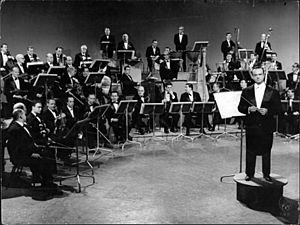
In 1963, he formed his Nuevo Octeto. He also won an award for his Tres Tangos Sinfónicos. In 1965, he released an album called El Tango. He worked with the writer Jorge Luis Borges on this album.
In 1967, he signed a contract with the poet Horacio Ferrer. They wrote an operetta called María de Buenos Aires. This introduced a new style of tango called Tango Canción (Song Tango). The next year, he wrote Balada para un loco with Ferrer. This song became his first big popular hit.
In 1970, Piazzolla went back to Paris. He wrote more music with Ferrer. He also premiered his famous Cuatro Estaciones Porteñas (Four Seasons of Buenos Aires).
Back in Buenos Aires, he formed his Conjunto 9 (Nonet). This was a dream come true for him. He wrote some of his most complex music for this group. He also played his first concert at the famous Teatro Colón in Buenos Aires.
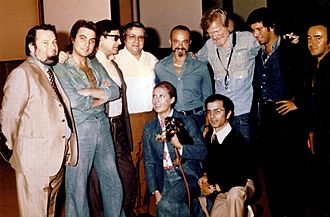
In 1973, he had a heart attack. That same year, he moved to Italy. He recorded many albums there for five years. His famous album Libertango was recorded in 1974. He also recorded Summit (Reunión Cumbre) with jazz saxophonist Gerry Mulligan.
In 1975, he created his Electronic Octet. This group used electric instruments and synthesizers. He also wrote the 'Suite Troileana to remember his friend Aníbal Troilo.
In 1978, he formed his second Quintet. He toured the world with this group for 11 years. This made him famous around the globe. He also started writing more classical and symphonic music.

During the time of military rule in Argentina (1976-1983), Piazzolla lived in Italy. But he often returned to Argentina. He even had lunch with the leader at one point. He later explained that he was simply invited and went.
In 1985, he received a special award in Argentina. His family later received an honor award for him.
Traveling the World with His Music
In 1982, he recorded the album Oblivion for a film. He also played a concert in Buenos Aires during the Falklands War. That same year, he wrote Le Grand Tango for cello and piano. It was for the famous cellist Mstislav Rostropovich.
On June 11, 1983, he played one of his best concerts. It was at the Teatro Colón in Buenos Aires. He brought back his Conjunto 9 and played with the Buenos Aires Philharmonic orchestra.
He performed at the Montreal International Jazz Festival in 1984. He also played with Italian singer Milva in Paris. A concert in Milan was recorded as the album Suite Punta del Este. He also played in the Netherlands, where his bandoneon playing was shown up close on TV.
In 1985, he was named an "Illustrious Citizen of Buenos Aires." He also played his Concerto for Bandoneon and Guitar in Belgium. He made his London debut with his second Quintet.
He won a French award for best film music in 1986. He also performed with vibraphonist Gary Burton at the Montreux Jazz Festival. In 1987, he gave a concert in Central Park in New York City. This was the city where he grew up.
In 1988, he wrote music for the film Sur. He also married Laura Escalada. He recorded his album La Camorra in New York. This was his last recording with the second Quintet. He also had a quadruple bypass operation that year.
In 1989, he formed his Sexteto Nuevo Tango. This was his last music group. They played a concert in Buenos Aires. This was Piazzolla's last concert in Argentina. He also played concerts in Amsterdam, Berlin, Rome, and London. He recorded Five Tango Sensations with the Kronos Quartet. This was his last studio recording. He then played solo with classical string groups and orchestras.
His piece Le grand tango was first played in 1990. On July 3, he gave his last concert in Athens, Greece. He had a cerebral hemorrhage in Paris on August 4, 1990. He fell into a coma. He died in Buenos Aires on July 4, 1992, without waking up.
Today, many musicians continue his legacy. They include composer Fernando Otero and bandoneonist Marcelo Nisinman. Pablo Ziegler, who played piano in Piazzolla's quintet, helps keep nuevo tango alive.
Musical Style
Piazzolla's nuevo tango was different from old tango. It added parts of jazz and classical music. It used more complex harmonies and sounds. It also used counterpoint, which is like weaving different melodies together. Piazzolla's music was so successful that it created a completely new style.
Many of his songs use a repeating bass line and chord pattern. This idea comes from old baroque music and jazz. He also used complex counterpoint, where each instrument plays its own important part. Another idea from jazz was improvisation. This is when musicians make up parts as they play.
After writing Adiós Nonino in 1959, Piazzolla often used a special structure for his songs. They would have fast parts, then slow parts, then fast again, and a final ending. The fast parts had strong tango rhythms. The slow parts often featured the string instruments or Piazzolla's bandoneon playing beautiful melodies. The piano usually kept the rhythm. The electric guitar added fancy improvisations. The double bass gave the music a strong, deep sound.
Piazzolla loved the quintet (five-person group) of bandoneon, violin, piano, electric guitar, and double bass. Many people think this was the best way to play his music. This group could create a very full sound, like a whole orchestra. Each musician also had a chance to show their unique style.
Even though he often used the quintet, Piazzolla always tried new things. In 1965, he made an album with Jorge Luis Borges. Borges read his poems over Piazzolla's very modern music. In 1968, Piazzolla wrote an "operita" (a small opera) called María de Buenos Aires. It used a bigger group of instruments and singers.
In the 1970s, Piazzolla lived in Rome. He explored a simpler, more flowing music style. This style had more jazz influence. Songs like Libertango show this new direction. In the 1980s, Piazzolla became very successful. He wrote some of his most ambitious works. These included Tango Suite for two guitars and Histoire du Tango for flute and guitar. He also wrote La Camorra, a long piece inspired by a crime family.
He formed his last group, the Sexteto Nuevo Tango, in 1989. He wrote even more daring music for this group. Piazzolla was like old classical composers such as Handel or Mozart. He loved to mix different music styles into his own songs. This made him very popular with classical and jazz musicians around the world.
Musical Career
After leaving Troilo's orchestra, Piazzolla led many different groups. These included the 1946 Orchestra, the 1955 Octeto Buenos Aires, the 1960 "First Quintet," the 1971 Conjunto 9, the 1978 "Second Quintet," and the 1989 New Tango Sextet. He was the director and bandoneon player in all of them.
He also recorded the album Summit (Reunión Cumbre) with jazz musician Gerry Mulligan. Piazzolla wrote about 3,000 pieces of music. He recorded around 500 of them. His famous songs include "Balada para un loco" and Adiós Nonino.
In 1984, he played concerts in Germany and the Netherlands. In 1985, he performed in London for a week. On September 6, 1987, his quintet played a concert in Central Park in New York. This concert was later released as an album.
Legacy
- The Astor Piazzolla International Airport in Mar del Plata is named after him.
- The music school "Conservatorio Superior de Música de la Ciudad de Buenos Aires" in Buenos Aires carries his name.
- Google celebrated his 100th birthday on March 11, 2021, with a special Google Doodle.
Ensembles
Astor Piazzolla led many different music groups throughout his career:
- Piazzolla's Orquesta Típica (Piazzolla's Traditional Orchestra), 1946–50.
- Orquesta de Cuerdas (String Orchestra), 1955–58.
- Octeto Buenos Aires (Buenos Aires Octet) 1955–58.
- Jazz Tango Quintet, 1959.
- Quinteto (Quintet), also known as the first Quintet, 1960–70.
- Nuevo Octeto (New Octet), 1963.
- Conjunto 9 (Ensemble 9), also known as Noneto, 1971–72 & 1983.
- Conjunto Electronico (Electronic Ensemble), also known as Electronic Octet, 1975.
- Quinteto Tango Nuevo (New Tango Quintet), also known as the second Quintet, 1979–91.
- Sexteto Nuevo Tango (New Tango Sextet), 1989–91.
Images for kids
See also
 In Spanish: Astor Piazzolla para niños
In Spanish: Astor Piazzolla para niños


